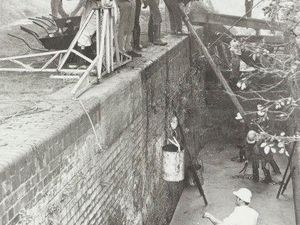The unlikely spy – how pensioner Melita Norwood passed nuclear secrets to the Russians
With her bottle-base thick glasses, lank, grey hair tamed by clips and penchant for dowdy cotton blouses, Melita Norwood appears an unlikely KGB Cold War weapon.

And the sleepy South Staffordshire parish of Wombourne, with its manicured village green, is an unlikely bolthole for one of the Kremlin’s best undercover operatives.
To residents, the smiling pensioner was a kindly, if somewhat dotty, addition to the community. Yes, she had strong political beliefs and proudly displayed a CND sticker in her window.
Yes, she sipped tea from her favourite Che Guevara mug. Yes, she pushed copies of communist daily newspaper The Morning Star through neighbours’ letterboxes.
But she was merely seen as a harmless eccentric who wrapped the old fashioned values of Nye Bevan socialism around her narrow shoulders like a knitted shawl.
Her warm, weathered features suggested a devotion to the WI, not the subterfuge conflict waged by Soviets.
Secret agents do not smell of lavender and don tweeds.
Yet Melita – “Hola” to her contacts behind the Iron Curtain – was a spy: a highly unlikely spy, but a very good one. So good, MI5 official historian Christopher Andrew dubbed her “the most important British female agent in KGB history and the longest serving of all Soviet spies in Britain”.
For decades, Melita syphoned secrets from the London based British Non-Ferrous Metals Research Association, a company that hid its true role of developing atomic weaponry behind a bland title that could’ve been bestowed on a West Midland bolt making business.
The title given to the secret Armageddon A-Bomb research was handed an even more mundane name. Tube Alloys.
Melita stole very meaty secrets, meaty enough to nudge Russia ahead in the nuclear arms race.
For decades, Melita got away with it. She was identified as a security risk in 1965, but had still not been grilled by the time of her retirement in 1972.
Melita was shuffling, slipper wearing proof that not all undercover agents swagger and smoulder like James Bond. She liked her Horlicks shaken, not stirred.
The only secret she appeared to possess was her recipe for the perfect damson jam.
Cold eyed courage at the casino tables was not for her, yet she could display steely belligerence during beetle drives staged at the sheltered housing complex that became her last address.
Even espionage author John le Carre, who specialised in grey characters with sinister secrets, would find Melita’s life a little too ordinary.
Rather than possessing a licence to kill, she indulged in shopping trips for frail neighbours. Those frequent visits to Wombourne’s stores would earn her a priceless tabloid title borrowed from one of le Carre’s most famous works.
Melita became “The Spy Who Came In From The Co-op”.
Hers is an incredible story, so incredible, it formed the basis for 2018 film Red Joan, starring Judi Dench.
Russia loved her, awarding Melita The Order of the Red Banner. The KGB publicly described her as “a committed, reliable and disciplined agent”. “She was a real heroine,” declared the Communist Party of Britain.
Her astonishing double life was finally lain bare in September, 1999, and a media circus erupted, with astonished neighbours looking on as an international press pack pounded on Melita’s door.
By then, the silver haired spy was 87 and so frail her twilight years were daily dimming darker. Widowed, Melita moved to Wombourne to be close to her daughter.
Prosecution was considered inappropriate due to ill health and advanced years.
Melita, suffering cancer and heart disease, died at Wolverhampton’s New Cross Hospital in 2005.
In fairness, she refused to take money from her Russian masters. Melita believed that by ensuring, through her leaks, no one was running away with the arms race, an apocalyptic mushroom cloud conflict would be avoided.
She even declined the offer of a Soviet pension. That, presumably, would’ve raised too many eyebrows at Wombourne Post Office.
When quizzed by reporters, she insisted: “I do not consider myself a spy. In general, I do not agree with spying against one’s country.
“I did what I did, not to make money, but to help prevent the defeat of a new system which had, at great cost, given ordinary people food and fares which they could afford, a good education and a health service.”
She added: “I did not want money. It was not that side I was interested in. I wanted Russia to be on equal footing with the West.”
With that explanation, the stooped OAP politely thanked journalists for their interest and closed the door of her home.
Melita was certainly politically naïve.
Christopher Andrew said: “She believed in a Soviet Union that never existed and she chose to ignore the barbaric treatment Stalin foisted on his own people.”
Author David Burke, who wrote a book about Melita’s early life, said: “She was not a hard-line Stalinist. She was an emotional Communist. She thought what she was doing was for the benefit of the whole world.”
Melita was always destined to follow the Red Flag, always destined to be a political animal.
Her Latvian father Alexander Sirnis produced a newspaper from the family’s Dorset home entitled “The Southern Worker: A Labour and Socialist Journal” which he handed it out to members of the British Communist Party.
British born mother Gertrude had been a suffragette.
Melita’s husband Hilary Nussbaum was of Russian-Jewish descent, a trade union official and Communist. He later anglicised the surname.
Melita followed suit and joined the Communist Party in 1936, a year later she gained employment at British Non-Ferrous Metals Research Association and was soon feeding information to the NKVD, the Soviet spy network that proceeded the KGB.
For years she fed juicy titbits to contacts, some of such magnitude one intelligence source remarked: “The information she supplied on the behaviour of uranium metal in high temperatures permitted the Soviet Union to test an atomic bomb four years earlier than British and American intelligence thought possible.”
Others questioned the worth of Melita’s information, arguing – perhaps to ease embarrassment within the secret service – that she’d merely told Russia what it already knew.
Melita would’ve remained unmasked if not for the defection of former KGB agent Vasili Mitrokhin to these shores.
As a sweetener for sanctuary, he handed over thousands of documents. Spy Hola’s name ran like a glinting seam through the pages. She was described as a “loyal, trustworthy and disciplined agent”.
The dossiers were less complimentary towards the infamous Cambridge Five spy ring – Donald Maclean, Guy Burgess, Kim Philby, Anthony Blunt and John Cairncross.
Burgess was “constantly under the influence of alcohol”, the papers stated.
Even more damning, Maclean was “not very good at keeping secrets”.
Melita was evidently very good at keeping secrets.
So good, that when she was initially unmasked by a Times article, her own daughter Anita – a school lab technician – was, to use a tabloid term, utterly gobsmacked.
She later said: “It was a complete shock at the time. I talked to her about the spying, but she told me very little of what she’d done, although she did say my father didn’t approve.
“Whatever she may have done, I loved her. She’s a very good person, very strong and totally unmaterialistic.”
The near unbelievable story of Melita Norwood may yet spawn another big screen blockbuster: Tinker, Tailor, Soldier, Sheltered Housing resident.





